Table of Contents
What is Plumbing Trap?
An attachment is fitted in a drainage system to stop foul gasses or air from the drain or sewer into the house, known as a trap or plumbing trap.
The water present in the trap functions as a barrier to the way of foul air. In its simplest form, it is simply like a loop or double bend in sanitary fittings.
Distance from the first bend top to the second bend bottom is the depth of the water seal.
The trap’s efficiency depends on the water seal depth. The depth of the seal varies from 40 mm to 75 mm based on the design of the traps.
A trap should be provided near the soil fitting or waste except for forming an essential fitting element, like a European water closet.
Purpose of Plumbing Trap
Plumbing consists of pipes that help to convey water to the building and takes the sewage away.
The sewer pipe is the medium that conveys the sewage to the disposal method. Sewer gases have a bad odour, and they may include potentially flammable methane.
Bacteria activity causes the formation of sewer gases due to the natural breakdown of solids in wastewater.
Common gases produced in the sewer system are nitrogen, carbon monoxide, methane, and hydrogen sulfide.
To avoid the entry of gases, insects, bacteria, Cockroaches, mice inside the home or building, traps are constructed at the end of soil or waste pipe.
Nearly all drainage pipes and fixtures in the house should have a trap. Traps are essential as this stop the sewer gases produce in drainage pipes from coming into the house.
Hence, all plumbing fittings like basins, bathtubs, kitchen sink and toilets etc., are provided with traps.
Requirements of a good Plumbing Trap
Following are the properties of good traps.
- It should operate an efficient water seal under all flow conditions, both during the water flow and the lack of water flow.
- It should be self-cleansing.
- It should not have any internal projections angles or contractions to permit unobstructed flow through it.
- It should have a smooth inner surface so that the flow of water automatically secures each part and there is no possibility of dust, dirt, etc., getting stuck to it.
- It should be fitted with suitable means of access for cleaning purposes.
Types of Plumbing Traps
Traps can be produced in different forms, and they are typically named after the shape of the letter they resemble.
Out of the different shapes, the trap resembling the letter p (or P-trap), Q (Q-trap), and S (strap) is more common.
The traps are generally made of castiron and glazed stoneware. Based on the uses and location, traps may be classified as follows.
Floor Traps or Nahani Traps
Traps provided to collect used water from the bathroom floor, kitchen, floor, etc., are known as floor traps or Nahanni traps.
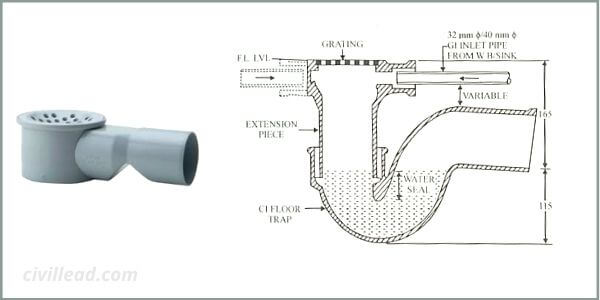
This type of trap is made of cast iron, and it is provided with a removable grating on top. The grating intercepts dust or other solid matters and prevents blockage of traps.
The minimum depth of water seal for the floor trap should be 40mm. Details of a 100 x 75 cast iron floor trap are shown in the picture above.
P Trap
This trap is suitable for an Indian WC (water closet). It is made from PVC or cast iron. It has a U shape tube that retains water and blocks the entry of foul gases. The p trap is helpful for an outlet by the wall.
S Trap
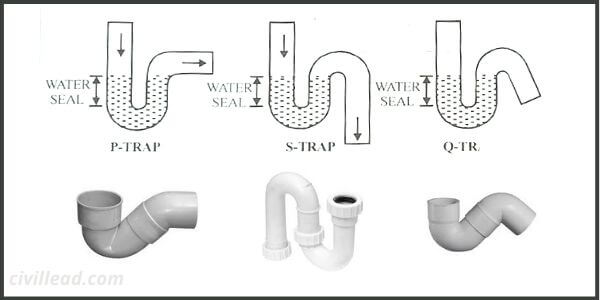
It is similar to the P trap with a slight shape difference and is used to fix WC (water closets) in toilets. The S-trap is helpful for an outlet on the floor.
Q Trap
Q trap is similar to strap and suitable for the upper story than the ground floor. It is provided under a water closet in the toilet. It is suitable for WC on the upper story other than ground.
Gully Trap
A deep seal trap is provided on the wall’s outer face for disconnecting the wastewater flowing from the bath, kitchen, basin, and floors to the primary drainage system.
The deepwater seal forms a barrier for preventing foul air from the house drain to inside the building. It is formed of cast iron or glazed stoneware.
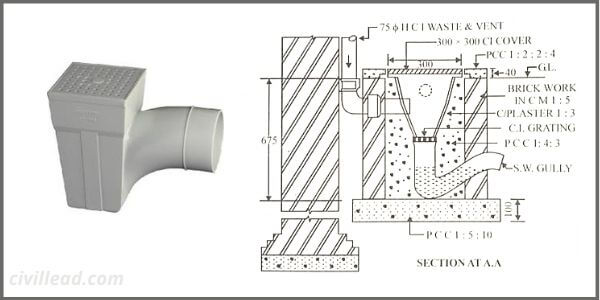
The stoneware gully trap has a top square in the plan, whereas the top of cast iron usually is circular.
A Gully trap is provided with a small masonry enclosure to coincide with the required invert level of waste pipe discharging into it.
Grating is provided on top of the trap to intercept and retain all solid matters and prevent them from flowing into the drain. The bars of the grating should not be more than 10 mm apart.
Bottle Trap
A bottle trap is suitable to collect waste from the kitchen sink, washbasin, and other sanitary items that don’t have a specific or built-in trap.
It consists of a vessel that has a diameter bigger than the plumbing pipe coming from the basin.
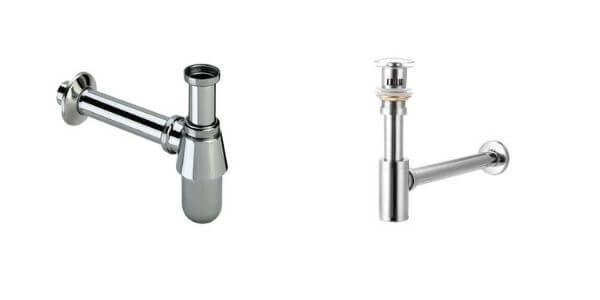
When the water flows down, this vessel fills with water, and the vessel always remains filled with a certain amount of water. Thus, it blocks the entry of foul gases.
Intercepting Trap
This trap is used at the junction of the house drain( inspection chamber) and street sewer to stop the foul gases entry from the sewer into the house.
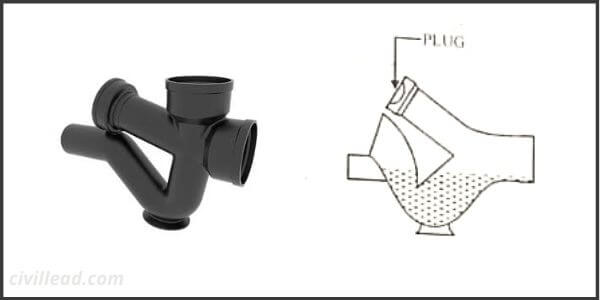
This trap helps to disconnect the building drain from the street sewer. The trap is built of glazed stoneware with an opening at the top(known as the cleaning eye).
The opening is kept closed with a tight-fitting plug that is taken out only while cleaning the trap. This trap has a deeper seal than regular traps. (not less than 100 mm).
Grease Trap
Grease traps are used in industries like hotels, restaurants, etc., producing a significant amount of greasy waste to remove the grease content of wastewater before discharging it into the drain.
If the greasy or oily matter is not removed being sticky, it will induce deposition of solids in the drain, which can obstruct the flow of water in the drain and may finally block the drain.
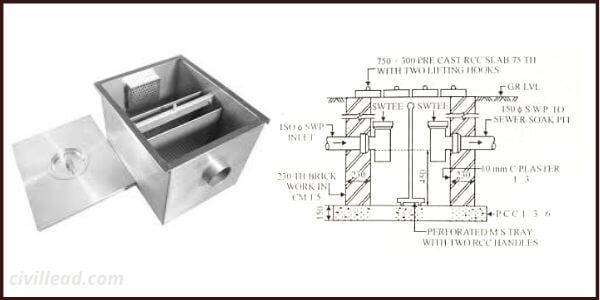
A grease trap consists of a cast iron or masonry chamber with a bent pipe or T to assist as the outlet.
The velocity of wastewater flow gets reduced on entering the grease trap( because of the separation of oily or greasy matter from the wastewater).
The greasy material rises as floating(in the trap), which is extracted regularly with a mild steel tray. The detail of the grease trap is shown in the image above.
Silt Trap
Silt traps are used only when the wastewater carries a significant amount of silt, sand, and coarse particles.
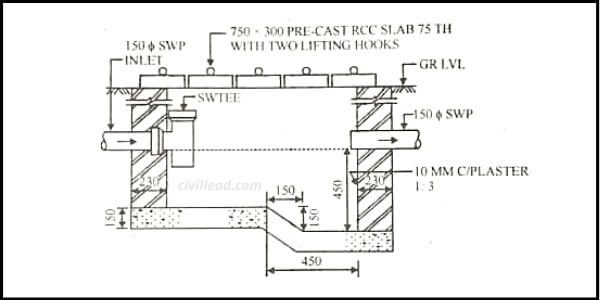
A masonry chamber works like a grit chamber that shares the silt, sand, etc., settling down before the wastewater is released into the drainage system. The details of the silt trap or silt chamber are shown in the picture above.
Drum Trap
The drum trap is like a metal drum, an essential part of our house plumbing system. Its wide openings permit you to locate and remove objects more efficiently. Only you need either retrieve or remove it from the plumbing system.

Its wide caps also enable you to insert into the trap comfortably. You can use a plumbing snake to remove clogs from the drain. It is commonly used for bathtubs.
When the water flows from drainage to plumbing trap, its bottom fills with water and always remains filled with a significant amount of water that helps to prevent sewerage gases from entering our home.
Running Trap
It has a depressed U shaped pipe section that remains filled with water in all state of water and allow free passage for water but block the entry of foul gases.

The running trap is not connected with any fixture. It is fitted in the drainage pipe.
This trap is susceptible to clog the drain, and cleaning of running this trap is difficult. You have to dig the ground to get the trap in the case of the clogged drain.
Straight Through Trap
This trap is suitable for limited space, and it can be hidden easily behind the basin pedestal. But the issue with this trap is its two tight bends which slow down the water flow.

It has a silicon membrane inside, which acts as a non-return valve and allows the water to flow from it but blocks the entry of foul air.
This trap is ideal for basins with a pedestal, and it comes with different adapters, which makes it suitable for various situations.
Low-Level Bath Trap
A low-level trap is suitable for a tight space under a shower and bath tray. This trap has a water seal of 40 mm that means it can’t be fitted in soil and vent pipe directly.

Bell Trap
Bell trap design makes it suitable to use in garages or outdoor uses. The water flows into a well of the drain system that works as a trap to hold foul air. The trap has a water seal inside that blocks sewer gas.

Building Trap
It is a U-shaped section provided in the main drain of the sewer as it moves away from your home. Building trap aims to hold water and create a block for sewer gases.
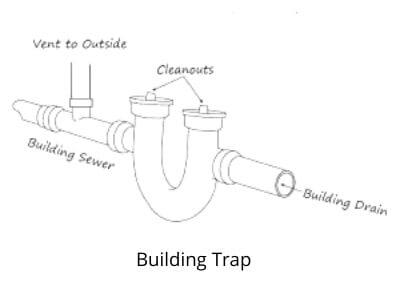
It was an old device of the plumbing practice that serves no objective in the modern house. Since today’s home, every fixture like the kitchen sink, washbasin, etc., has its trap.
Also, Read
Difference Between Ceramic Tiles and Vitrified tiles
Standard Room Sizes & Their Location In Residential Building
8 Types of Stairs, Flight of Stairs
Parapet Wall – Purpose, Types & Uses
What is Pointing? – Types of Pointing, Purpose and Method
Difference Between English Bond and Flemish Bond